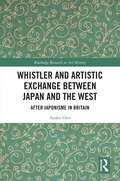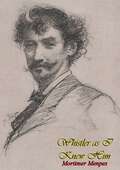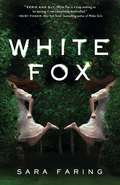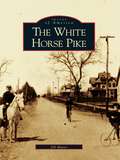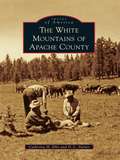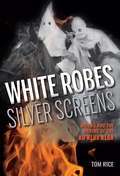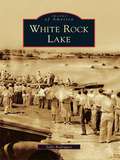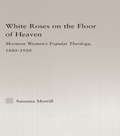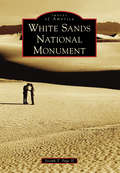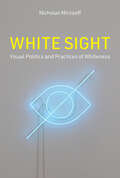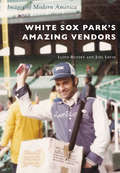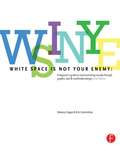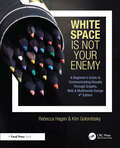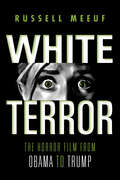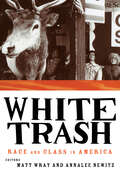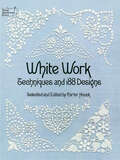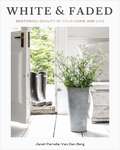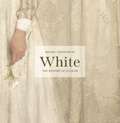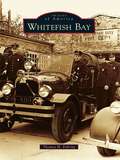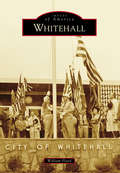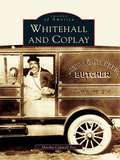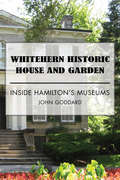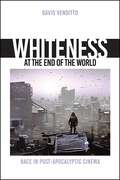- Table View
- List View
Whistler and Artistic Exchange between Japan and the West: After Japonisme in Britain (Routledge Research in Art History)
by Ayako OnoOno examines cross-cultural artistic exchange between the West and Japan from the late nineteenth century to the early twentieth century. Studies of Japonisme have been dominated by searching out relationships of influence between artworks–trying to identify which specific works influenced a particular artist. Ono argues that a more holistic understanding of 'spillover effects' is necessary in fully comprehending the nuances of these relationships. She bases this argument on documents and works of art in the context of globalisation, looking at the relationships between James McNeill Whistler and others with their contemporaries in the Japanese artistic and literary worlds. This was a more complex two-way exchange than is often appreciated, with Western artists taking inspiration from (to them) new Japanese styles, while Japanese artists and writers were trying to craft a 'modern', more western-influences style to reflect the modern nation of Japan emerging onto the world stage after centuries of relative isolation. A fascinating analysis of the role of globalisation and cultural exchange in the development of new and hybrid artforms, that will be essential reading for scholars of this fascinating period in international art history.
Whistler as I Knew Him
by Mortimer MenpesMortimer Menpes’ biography of American painter James McNeill Whistler, lavishly illustrated with colour plates and plates in monochrome throughout. Best known for the painting made depicting his mother, James McNeill Whistler was an American painter who worked mostly in the United Kingdom, his works often sentimental in nature. Mortimer Menpes was a British painter, illustrator and printmaker. He created a form of colour etching, as well as publishing 'War Impressions', the first book to reproduce coloured art works faithfully, making him a pioneer of illustrated art books. Menpes had been a pupil of Whistler, having met him in Brittany in 1880. Illustrated with a frontispiece portrait of Whistler, as well as one hundred and thirty-four plates in colour and black and white. – Print ed.
White Cottage, White House: Irish American Masculinities in Classical Hollywood Cinema (SUNY series, Horizons of Cinema)
by Tony TracyWhite Cottage, White House examines how Classical Hollywood cinema developed and deployed Irish American masculinities to negotiate, consolidate, and reinforce hegemonic whiteness in midcentury America. Largely confined to discriminatory stereotypes during the silent era, Irish American male characters emerge as a favored identity with the introduction of sound, positioned in a variety of roles as mediators between the marginal and mainstream. The book argues that such characters function to express hegemonic whiteness as ethnicity, a socio-racial framing that kept immigrant origins and normative American values in productive tension. It traces key Irish American male types—the gangster, the priest, the cop, the sports hero, and the returning immigrant—who navigated these tensions in maintenance of an ethnic whiteness that was nonetheless "at home" in America, transforming from James Cagney's "public enemy" to John Wayne's "quiet man" in the process. Whether as figures of Depression-era social disruption, avatars of presidential patriarchy and national manhood, or allegories of postwar white flight and the nuclear family, Irish American masculinities occupied a distinctive and unrivaled visibility and role in popular American film.
White Fox
by Sara FaringAfter their world-famous actor mother disappeared under mysterious circumstances, Manon and Thaïs left their remote Mediterranean island home—sent away by their pharma-tech tycoon father. Opposites in every way, the sisters drifted apart in their grief. Yet their mother's unfinished story still haunts them both, and they can't put to rest the possibility that she is still alive.Lured home a decade later, Manon and Thaïs discover their mother’s legendary last work, long thought lost: White Fox, a screenplay filled with enigmatic metaphors. The clues in this dark fairytale draw them deep into the island's surreal society, into the twisted secrets hidden by their glittering family, to reveal the truth about their mother—and themselves. An Imprint Book
White Horse Pike, The
by Jill MaserThe White Horse Pike may not be America's most famous road, but it is one of the most storied. Originally a migratory footpath of the Leni-Lenape, this timeless 60-mile route from the Delaware to the Atlantic has been followed by everyone from Walt Whitman to the Jersey Devil. It has served as a stagecoach highway, a toll road, and a pattern for railroads. The White Horse Pike depicts the heyday of this still popularcity-to-shore road, the most direct route from Camden to Atlantic City.
White Mountains of Apache County, The
by Catherine H. Ellis D. L. TurnerTowns and communities such as Springerville, Eagar, Alpine, Nutrioso, Vernon, Greer, McNary, and Maverick of Apache County's White Mountains hold fascinating histories of outlaws and Arizona Rangers; Texas cattlemen and Mormon farmers; and New Mexico Hispanics and forest service men. Aldo Leopold was one of the forest service men who, in A Sand County Almanac, described the Boneyard, Campbell Blue, and Frijole Cienega. Of Paradise Valley, he wrote, "What else could you call it?" In 1913, the Good Roads Association described the roads winding through the area with "canyons that are flanked on every side by timber-covered, snow-clad peaks." It also noted that the area had become "an interesting point for the genuine home seeker, who will not likely want to continue his journey farther." That description remains true today.
White Robes, Silver Screens
by Tom RiceThe Ku Klux Klan was reestablished in Atlanta in 1915, barely a week before the Atlanta premiere of The Birth of a Nation, D. W. Griffith's paean to the original Klan. While this link between Griffith's film and the Klan has been widely acknowledged, Tom Rice explores the little-known relationship between the Klan's success and its use of film and media in the interwar years when the image, function, and moral rectitude of the Klan was contested on the national stage. By examining rich archival materials including a series of films produced by the Klan and a wealth of documents, newspaper clippings, and manuals, Rice uncovers the fraught history of the Klan as a local force that manipulated the American film industry to extend its reach across the country. White Robes, Silver Screens highlights the ways in which the Klan used, produced, and protested against film in order to recruit members, generate publicity, and define its role within American society.
White Rock Lake
by Sally RodriguezIn 1909, Dallas city leaders approved the damming of White Rock Creek to create a new water source for the increasing needs of a growing city. As a result, so much of the life and history of Dallas has echoed through the life and history of White Rock Lake. In the early decades, the lake was home to many private summer homes and boat houses, as well as hunting and fishing clubs. Soon thereafter, a bathing beach, sailing clubs, public boathouses, and picnic facilities were added. The Civilian Conservation Corps and the Works Progress Administration transformed the lake with more recreational and leisure amenities. World War II brought increased military uses that included a POW camp for German officers. Those early city leaders could hardly know that the lake they were creating 10 miles outside of Dallas would become an urban oasis enjoyed by over two million visitors a year.
White Roses on the Floor of Heaven: Mormon Women's Popular Theology 1880-1920 (Religion in History, Society and Culture)
by Susanna MorrillFirst published in 2006. Routledge is an imprint of Taylor & Francis, an informa company.
White Sands National Monument
by Joseph T. Page IIThe world's largest gypsum dune field, the 275-square-mile dunes of White Sands National Monument are a geologic oddity more than 250 million years in the making. Located in Southern New Mexico, the popularity of the monument draws nearly half a million visitors each year to the National Park Service's southwestern region. The area is protected from encroachment by the boundaries of the US Army's White Sands Missile Range and houses no less than 144 species of birds, 20 unique mammals, and 371 types of insects. The gypsum's beauty has been captured by photographers and filmmakers for more than a century. Both Hollywood and scientists alike have sought after the monument's stunning otherworldly visuals to mimic other countries and worlds. The deserts of Qatar were recreated for Transformers (2007), and the monument has been identified as a potential analog site for Mars.
White Sight: Visual Politics and Practices of Whiteness
by Nicholas MirzoeffFrom the author of How to See the World comes a new history of white supremacist ways of seeing—and a strategy for dismantling them.White supremacy is not only perpetuated by laws and police but also by visual culture and distinctive ways of seeing. Nicholas Mirzoeff argues that this form of &“white sight&” has a history. By understanding that it was not always a common practice, we can devise better ways to dismantle it. Spanning centuries across this wide-ranging text, Mirzoeff connects Renaissance innovations—from the invention of perspective and the erection of Apollo statues as monuments to (white) beauty and power to the rise of racial capitalism dependent on slave labor—with the ever-expanding surveillance technologies of the twenty-first century to show that white sight creates an oppressively racializing world, in which subjects who do not appear as white are under constant threat of violence. Analyzing recent events like the George Floyd protests and the Central Park birdwatching incident, Mirzoeff suggests that we are experiencing a general crisis of white supremacy that presents both opportunities and threats to social justice. If we do not seize this moment to dismantle white sight, then white supremacy might surge back stronger than ever. To that end, he highlights activist interventions to strike the power of the white heteropatriarchal gaze. White Sight is a vital handbook and call to action for anyone who refuses to live under white-dominated systems and is determined to find a just way to see the world.
White Sox Park's Amazing Vendors (Images of Modern America)
by Lloyd Rutzky Joel LevinBaseball lives, whether one interprets that as meaning that the country's national pastime is still breathing and well after nearly two centuries or as a reference to the people who work in the "industry." More than 50 years ago, one young man became employed by the Chicago White Sox and began photographing virtually everybody with whom he worked. His intention was to have pictures of his friends and coworkers for the future. Now, Arcadia Publishing is proud to add Lloyd Rutzky's memories of his "team" experiences to its Images of Modern America series in this volume, a companion to the groundbreaking Wrigley Field's Amazing Vendors, published in 2018.
White Space Is Not Your Enemy: A Beginner's Guide To Communicating Visually Through Graphic, Web And Multimedia Design
by Kim Golombisky Rebecca HagenDesigning a website or brochure without an art background? Then step away from the computer and read this engaging, conversational introduction to visual communications first. Written for the beginner, White Space is Not Your Enemy, Second Edition, is a practical graphic design and layout guide that introduces the concepts and practices necessary for producing effective visual communication across a variety of formats--from web to print. <P><P> This beautifully illustrated, full-color book covers all of the basics to help you develop your eye and produce evocative designs that work. Topics include: <P> * What is design? <P> * Pre-design research and brainstorming. <P> * The "works-every-time layout" and "13 layout sins." <P> * The elements and principles of design. <P> * Layouts for impact. <P> * Getting along with type. <P> * Choosing and using color. <P> * Working with photos and illustrations. <P> * Intros to infographics, storyboarding and multimedia components. <P> * Output for the web and print. <P> Visit www. whitespacedesignbook. com for additional supporting materials.
White Space Is Not Your Enemy: A Beginner's Guide to Communicating Visually Through Graphic, Web & Multimedia Design
by Kim Golombisky Rebecca HagenDESIGNING a website or brochure without an art background? Then step away from the computer and read this engaging conversational introduction to visual communications first. Written for the beginner, White Space Is Not Your Enemy is a practical graphic design and layout guide that introduces the concepts and practices necessary for producing effective visual communication across a variety of formats—from web to print. This beautifully illustrated full-color book covers all of the basics to help you develop your eye and produce evocative designs that work.Topics include: What is design? Predesign research & brainstorming The elements & principles of design Layouts for impact Getting along with type Choosing & using color Working with photos & illustrations Creating infographics Designing for web & social media
White Terror: The Horror Film from Obama to Trump
by Russell MeeufWhat kinds of terror lurk beneath the surface of White respectability? Many of the top-grossing US horror films between 2008 and 2016 relied heavily on themes of White, patriarchal fear and fragility: outsiders disrupting the sanctity of the almost always White family, evil forces or transgressive ideas transforming loved ones, and children dying when White women eschew traditional maternal roles. Horror film has a long history of radical, political commentary, and Russell Meeuf reveals how racial resentments represented specifically in horror films produced during the Obama era gave rise to the Trump presidency and the Make America Great Again movement. Featuring films such as The Conjuring and Don't Breathe, White Terror explores how motifs of home invasion, exorcism, possession, and hauntings mirror cultural debates around White masculinity, class, religion, socioeconomics, and more. In the vein of Jordan Peele, White Terror exposes how White mainstream fear affects the horror film industry, which in turn cashes in on that fear and draws voters to candidates like Trump.
White Trash: Race and Class in America
by Annalee Newitz Matt WrayFirst published in 1997. Routledge is an imprint of Taylor & Francis, an informa company.
White Work: Techniques and 188 Designs
by Carter HouckIn dozens of countries and in hundreds of varieties, the venerable craft of white work has become a byword for the ultimate form of needlework elegance. Its 3,000-year history encompasses every conceivable form of garment and decorative linen, from peasant blouses to papal vestments and the bridal gowns of queens; it appears in many guises as the favored embroidery of needleworkers from Denmark to South Africa, from England to the Philippines.Unfortunately, white work has frequently been neglected in the United States because of its underserved reputation as a difficult form of embroidery -- the type of work that, as author Carter Houck states, is never seen "beyond the glass cases of a museum." In reality white work can be performed at all levels of expertise; even more important, Ms. Houck shows that superb results can be achieved without laborious practice and prodigious technique. From these pages white work emerges as a vibrant and continually evolving form of contemporary embroidery that is both beautiful in itself and valuable for its myriad uses.Ms. Houck assumes no previous knowledge of white work and provides complete information on materials, pattern-transferring techniques, and instructions and diagrams for over 20 stitches: the simple chain stitch and running stitch; satin stitches and French knots; and more difficult "virtuoso" techniques like the Star and Shadow.Following the instructions are 40 pages of magnificent patterns, including florals, repeats, abstract designs, spot and corner decorations in a wide variety of sizes and moods, and two complete sets of alphabets for use as monograms. For each design Ms. Houck has suggested a stitch or stitches that produce optimal effects. As a result, the book acts as a self-contained guide to white work that can transform blouses, cuffs, collars, scarves, place settings, curtains, or any embroidery medium into treasures of heirloom quality.
White and Faded: Restoring Beauty in Your Home and Life (Perfect for People Who Love Interior Design, Decorating, and Creating Beautiful, Healing Spaces at Home)
by Janet Parrella-Van Den BergFind new value, purpose, and joy as you restore and uncover beauty in your home and (most importantly) in your life.The only thing more beautiful than home transformation is personal transformation. In White & Faded Janet Parrella-Van Den Berg takes you on a hope-filled journey to discover the hidden beauty in your own home and heart.We've all experienced it at some time, like an old piece of furniture we have felt unloved, discarded, neglected, or valueless. We've struggled with our own self-worth in moments of darkness when we feel like nobody cares about us and nobody wants us. But in these moments of despair sometimes the beginning of a journey toward hope can come from unlikely sources…like uncovering the charm and elegance of an antique chair or dresser that has had its true worth obscured by years of disuse and realizing that like that antique we still have beauty and life within ourselves. In White & Faded, Janet Parrella-Van Den Berg takes you on a stunning photographic tour through her restored English homes as she invites you into her personal journey of restoring her own sense of value and purpose—and reveals how you can do the same. So, what is White & Faded? As Janet explains, she loves white things as a culmination of all colors and a representation of new mercies. And she loves faded things, such as cast-aside furniture, as a reminder that even what is painful, or imperfect can be repurposed to reveal hidden beauty.Throughout this gorgeous and inspiring book, Janet gives you insights into both the literal and metaphorical aspects of white and faded as she draws on her decades of experience to offer you:Full-color photography of restored English country homes, including a 1767 Georgian rectory in Kent and a home originally built in 1500Practical restoration tips—from large-scale homes to smaller antiquesFresh decorative ideas you can adapt to your own style, home, and season of lifeFun inspiration—from antique to modern—ideal for fans of HGTV and Magnolia NetworkInspiration to incorporate a touch of seasonal charm throughout the yearHow to make white work with kids and petsA window into her own remarkable story of trauma, love, and rediscovered identity White & Faded will inspire you as you begin to create a place in your life where you feel loved, find healing, and discover new treasures. You deserve to feel loved, begin the journey today to restore your home and your heart.
White: The History of a Color
by Michel PastoureauFrom the acclaimed author of Blue, a beautifully illustrated history of the color white in visual culture, from antiquity to todayAs a pigment, white is often thought to represent an absence of color, but it is without doubt an important color in its own right, just like red, blue, green, or yellow—and, like them, white has its own intriguing history. In this richly illustrated book, Michel Pastoureau, a celebrated authority on the history of colors, presents a fascinating visual, social, and cultural history of the color white in European societies, from antiquity to today.Illustrated throughout with a wealth of captivating images ranging from the ancient world to the twenty-first century, White examines the evolving place, perception, and meaning of this deceptively simple but complex hue in art, fashion, literature, religion, science, and everyday life across the millennia. Before the seventeenth century, white’s status as a true color was never contested. On the contrary, from antiquity until the height of the Middle Ages, white formed with red and black a chromatic triad that played a central role in life and art. Nor has white always been thought of as the opposite of black. Through the Middle Ages, the true opposite of white was red. White also has an especially rich symbolic history, and the color has often been associated with purity, virginity, innocence, wisdom, peace, beauty, and cleanliness.With its striking design and compelling text, White is a colorful history of a surprisingly vivid and various color.
Whitefish Bay
by Thomas H. FehringThe abundance of whitefish in the Lake Michigan bay that frames this village gave it its name. The whitefish also helped feed the appetites of patrons of the resorts that once graced the community. Whitefish Bay quickly grew away from fishing and resorts to become the "Gold Coast" village north of Milwaukee. Nestled close enough to the city to allow an easy work commute, yet far enough away to provide an attractive community atmosphere, Whitefish Bay became a desirable location for families to put down roots. Stately homes went up alongside early farmhouses. Stores and other vibrant commercial enterprises quickly followed along with schools, churches, clubs, and organizations that continue to provide residents with a strong sense of community.
Whitehall (Images of America)
by William FloodThe city of Whitehall, skirting the eastern edge of Columbus, Ohio, is an undiscovered treasure of postwar America. The Lustron Corporation, based in Whitehall, lays claim to the origins of the prefabricated housing industry. The nation's first shopping center, the Town and Country, was built in the village in the late 1940s. The National Road passes through Whitehall, which helped create businesses offering lodging, meals, and entertainment on par with those along the storied Route 66. Images of America: Whitehall also pays homage to one of the most beloved tiki restaurants ever to grace the country: the famed Kahiki. This chronicle seeks to honor the amazing history of the "City of Pride."
Whitehall and Coplay
by Martha Capwell FoxWhen the first German, Huguenot, and Scotch-Irish settlers arrived in what is now Whitehall Township nearly three hundred years ago, their lives were fraught with peril. Some of the first families were nearly wiped out in raids during the French and Indian War. After the United States was established, the township settled into a long tranquil farming period, which lasted until the arrival of iron and the iron horse in the 1850s. Then, the Lehigh Valley became the cradle of the Industrial Revolution. Communities such as Egypt, Hokendauqua, Coplay, and Fullerton sprang up around iron mills, cement plants, and railroads. The new industries brought entrepreneurs, innovators, and immigrants to Whitehall and Coplay, changing the face of the township in many ways that are still visible today.
Whitehern Historic House and Garden: Inside Hamilton's Museums
by John GoddardInside Hamilton’s Museums helps to satisfy a growing curiosity about Canada’s steel capital as it evolves into a post-industrial city and cultural destination. In this special excerpt we visit Whitehern historic home and garden, which comes with three generations' worth of family possessions — everything from antique furniture to paintings, photographs, diaries, letters, and old toys. John Goddard takes us on a detailed tour of the historic home, providing fascinating historical background and insight into the McQuesten family secrets.
Whiteness at the End of the World: Race in Post-Apocalyptic Cinema (SUNY series, Horizons of Cinema)
by David VendittoThe use of Christian apocalyptic myths has changed significantly over the centuries. Initially used by genuinely disenfranchised groups, they are used today as a response to more egalitarian treatment of minorities in American society. The apocalyptic framework allows the patriarchy to frame itself as the victim who must restore America to a past where white male power went uncontested. This kind of white anxiety over increasing minority rights frequently manifests itself in contemporary apocalyptic media, which often depicts a white male hero facing a wide array of threatening "Others." Taking a unique look at the parallels between apocalypticism and American frontier mythology, as well as conspiracy theories and the post-apocalyptic obsession with repurposed objects, Whiteness at the End of the World analyzes many well-known films from the past fifty years, from Planet of the Apes to I Am Mother. It offers unique, clearly presented insights into recurring patterns that appear in an extraordinarily ubiquitous genre that has only increased in popularity, and whose themes of racial anxiety are increasingly pertinent in our increasingly contentious political climate.
